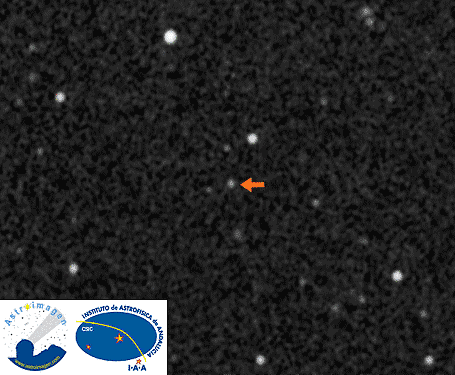Emily Lakdawalla • Apr 30, 2014
When will we know which is bigger, Pluto or Eris?
One of the things I enjoy about space exploration is the fact that many of the questions that motivate space science research are very easy to understand. But their answers can be surprisingly difficult to obtain. An apparently simple question about the solar system that has turned out to be hard to answer: What is the biggest thing in the Kuiper belt? We know for certain that Eris is more massive than Pluto, but that's not how schoolkids usually order the sizes of things in solar system: what they care about is diameter. And we don't presently know which one has a bigger diameter, Pluto or Eris. It's going to be a while before we find out, if at all.
When Eris was first discovered, its inherent brightness (which was significantly brighter than Pluto) implied it was probably larger than Pluto. But this wasn't a sure thing. The brightness of a distant object is a function of both its size and of how bright or dark its surface is. Pluto, we knew already, was an icy world. Its surface was about as reflective as that of icy outer solar system moons like Europa or Dione. Eris might have a surface as reflective as Pluto's, or even a little more, but it could be darker, possibly by a lot; so it was most plausible at the time of discovery that Eris was bigger than Pluto.
But then things got weird. In 2010, astronomers watched as Eris crossed in front a faint star. Watching such occultations can allow astronomers to measure the diameter of an object very precisely. We know the orbit pretty well, so we know the orbital speed pretty well, so timing how long the starlight winks out lets you determine how big the thing was where it crossed the star. Do this from several telescopes in different locations, and you can map out the two-dimensional shape of the world on the sky, which gives you a pretty precise number on its diameter. It turned out that Eris was much smaller than people thought; it was faking being the biggest object by being a very bright, reflective object. In fact, Bruno Sicardy, who eventually published a paper on this, said that it was now impossible to say which was bigger: "Eris appears as a Pluto twin."

Sicardy and his coworkers had a very precise measure for Eris' diameter: 2,336 +/- 12 kilometers. But in the abstract to their 2011 paper, they compared it to a much less precise number for Pluto: between 2,300 and 2,400 kilometers. We've studied Pluto for most of a century. How do we not know Pluto's diameter yet?
Pluto's diameter has been very difficult to determine because of its pesky atmosphere, which refracts starlight, so it spoofs the timing of the stellar occultation. (You can see the contrast between stellar occultations by Charon, which lacks an atmosphere, and Pluto, in this blog entry.) I was prompted to write about this subject by a recent paper by Emmanuel Lellouch and coworkers that reports a new estimate of Pluto's diameter. The paper isn't directly about Pluto's diameter; it is actually about the variation of methane abundance in Pluto's atmosphere with altitude, time, and geography. But one consequence of Lellouch's models is an estimate of where that atmosphere bottoms out -- that is, the location of the surface. The atmospheric modeling work is more consistent with a shallower atmosphere and hence larger Pluto, with diameter of more than 2360 kilometers; the "best guess" value is 2368, which would certainly be larger in diameter than Eris.
Lellouch's estimate is just the latest of many attempts to pin down Pluto's diameter; it's a compelling argument and adds a bean to the "it's bigger" jar but isn't conclusive. Fortunately, we're about to have a close flyby of Pluto by a spacecraft that should settle this question once and for all, as long as the two worlds are not so close in size as to still be indistinguishable after the New Horizons flyby. I sent an email to New Horizons principal investigator Alan Stern asking when New Horizons would finally answer this question, and how exactly they would be able to make the determination. Alan sent a lengthy response:
"The answer is a little complex, largely because we already know the radius to +/- 20 kilometers, or about +/-2%." (That is, they know the diameter to +/- 40 kilometers.) "So significant refinements depend on the details, and will likely only come late, and possibly even after flyby when we can reconstruct the 3-D shape to a volume and then an equivalent average radius of the triaxial ellipsoid." What Alan is talking about here: using one number, the "diameter" of a world, to state its size, assumes its shape is a sphere. But most "round" worlds are not spheres, not even (or especially) the biggest ones like Jupiter and Saturn. Most round worlds bulge in the middle due to their rotation (although slow-rotating dense worlds like Venus and Mercury do not). Smaller worlds that are locked into spin-orbit resonance, like most of the solar system's biggish moons, usually have an ellipsoidal shape, where their polar axis is shortest and the axis that points to the thing it's orbiting is longest. Pluto is likely to be a few kilometers shorter, pole-to-pole, than it is around the middle, and will most likely be broadest in the direction pointing to Charon. Its "diameter" will be the diameter of a sphere with equivalent volume to Pluto's ellipsoidal shape.
As for how they are going to make the measurement, Alan continued: "Radio occultation and direct imaging is our best bet, but radio only gives us one chord and not a central one, so shape effects will make any result from [the radio experiment] model-dependent." Translation: they will get a really precise number for how wide across Pluto is by timing the disappearance and reappearance of New Horizons' radio signal, but they aren't passing through the line that contains both Pluto's center and Earth, so they'll measure a smaller diameter and will have to use physics and geography to figure out what that smaller number implies for the biggest diameter. And anyway, as he already mentioned, Pluto is a triaxial ellipsoid so you have to figure out all its dimensions to determine its average diameter.
Alan went on: "My bet is that we'll likely need the best maps to nail this exactly, though just knowing if it's 1180, 1160, or 1140 kilometers -- i.e., distinguishing to +/- 1% -- will be far easier than getting down to the 1-kilometer final number." If Pluto really is 2360-plus kilometers in diameter, as the Lellouch et al. paper suggests, we'll be able to say fairly soon after the flyby that Pluto is bigger that Eris. If the New Horizons results surprise us yet again, and we find out that Pluto is 2280 kilometers across, we'll know fairly soon that Eris is bigger.
But it's also quite possible that the flyby data will give us an answer of 2240 +/- 20 kilometers, still indistinguishable from Eris, and we'll have to wait a year or more before the mappers have made an accurate determination. Alan again: "As is the history of Pluto and New Horizons, delayed gratification remains the rule of the day." But that's just fine as far as I'm concerned; it's a good thing to have reasons, a year or more after the flyby, to keep New Horizons coming back in the news. The mission will remain productive for many years after the Pluto encounter. Assuming everything goes well. (Please, please let everything go well.)
Even a year after the flyby, there remains the pathological possibility that Eris and Pluto really are indistinguishable in size based upon the available data. I wouldn't put it past Eris to continue posing a thorny problem for Pluto.
If I'm being honest, I'd enjoy the case where Eris was smaller than Pluto, because then you have the fun situation of Eris being heavier and Pluto being bigger -- just like Neptune and Uranus, respectively. In explaining a situation like this, there's the opportunity to do a lot of education. Cases like this remind us that nature is not required to comply with our human desires to organize things into tidy little boxes; there may be patterns, but patterns can be broken. It's these transitional cases, the annoying objects that refuse to fit into our boxes, that tell us the most about how slightly different initial conditions produced the diversity of solar system worlds we now enjoy. How can you make two identically-sized worlds on similar orbits with such different masses? We don't know yet! But it's a fun puzzle.
Many thanks to Alex Parker for making me the graphic that accompanies this article when he should have been doing something else.
Before you comment, please see this post on our Pluto comment policy.
Let’s Go Beyond The Horizon
Every success in space exploration is the result of the community of space enthusiasts, like you, who believe it is important. You can help usher in the next great era of space exploration with your gift today.
Donate Today

 Explore Worlds
Explore Worlds Find Life
Find Life Defend Earth
Defend Earth


